REAR COMBINATION LIGHT [(E)]
id0918007061x2
Purpose
• The rear combination lights are used to signal the following conditions to vehicles/people at the rear.
-
― Rear turn lights: Signals a left or right turn of the vehicle.
― Brake lights: Signals a vehicle deceleration or stop.
― Taillights: Signals the presence of the vehicle to vehicles/people at the rear during nighttime.
Function
• The related light turns on or flashes according to the operation of each switch.
|
Operation switch
|
Related light
|
Operation condition
|
|
Turn switch
|
Rear turn light
|
Flashes
|
|
Hazard warning switch
|
|
Brake switch
|
Brake light
|
Turns on
|
|
Light switch (TNS (parking lights))
|
Taillight
|
Turns on
|
Structure/Construction
• The rear combination light is integrated with the following parts.
-
― Rear turn light (LED)
― Brake light/taillight (LED)
-
Note
-
• Fogging or condensation on the inside of the rear combination lights may occur, however, it is a natural phenomenon occurring as a result of a temperature difference between the interior and exterior of the combination lights and has no effect on the light performance. Fogging or condensation will dissipate when the temperature inside the rear combination lights rises after the rear turn lights are illuminated and a period of time has elapsed.
Operation
Rear turn light
-
Turn light system
-
1. When the turn switch is in the LH or RH position, the instrument cluster detects (1) a turn switch LH signal or turn switch RH signal.
2. The instrument cluster sends (2) the turn switch LH signal or turn switch RH signal to the body control module (BCM) via CAN communication.
3. When the body control module (BCM) receives the turn switch LH signal or turn switch RH signal with the main power switched ON (READY off or on), it sends (3) a turn light (LH) flash request signal or turn light (RH) flash request signal to the electrical supply unit (ESU) via CAN communication.
4. When the electrical supply unit (ESU) receives the turn light (LH) flash request signal or turn light (RH) flash request signal, it flashes (4) the rear turn light (LH) or rear turn light (RH).
-
Hazard warning system
-
1. When the hazard warning switch is turned on, the climate control unit detects (1) a hazard warning switch on signal.
2. The climate control unit sends (2) the hazard warning switch on signal to the body control module (BCM) via CAN communication.
3. When the body control module (BCM) receives the hazard warning switch on signal, it sends (3) a turn light (LH) flash request signal and turn light (RH) flash request signal to the electrical supply unit (ESU) via CAN communication.
4. When the electrical supply unit (ESU) receives the turn light (LH) flash request signal and turn light (RH) flash request signal, it flashes (4) the rear turn light (LH) and rear turn light (RH).
Brake light
-
Operation due to brake pedal operation
-
1. When the brake pedal is depressed, the brake switch (No.1 signal) turns on (1).
2. When the brake switch (No.1 signal) turns on, the electrical supply unit (ESU) detects (2) a brake switch (No.1 signal) on signal.
3. When the electrical supply unit (ESU) detects the brake switch (No.1 signal) on signal, it turns the brake lights on (3).
-
Operation due to operation request signal from body control module (BCM)
-
1. When the operation conditions are met, the body control module (BCM) sends (1) the brake control request signal to the electronically controlled brake unit via CAN communication.
-
Note
-
• For the operation conditions, refer to the followings:
-
2. The electronically controlled brake unit sends (2) the brake control request signal to the electrical supply unit (ESU) via CAN communication as a brake light signal.
3. When the electrical supply unit (ESU) receives the brake light signal, it turns the brake lights on (3).
Taillight
1. When the light switch is in the TNS (parking lights) position, the instrument cluster detects (1) a TNS (parking lights) signal.
2. The instrument cluster sends (2) the TNS (parking lights) signal to the body control module (BCM) via CAN communication.
3. When the body control module (BCM) receives the TNS (parking lights) signal, it sends (3) a TNS (parking lights) on request signal to the electrical supply unit (ESU) via CAN communication.
4. When the electrical supply unit (ESU) receives the TNS (parking lights) on request signal, it turns the taillights on (4).
